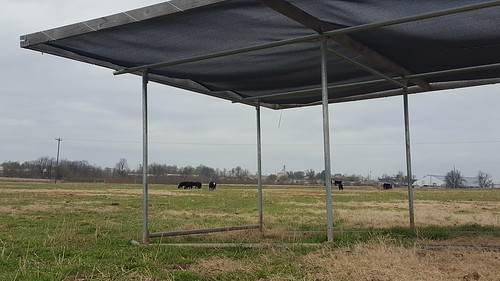To shade or not to shade: no one asks the cattle
By Fred Miller
U of A System Division of Agriculture
March 31, 2017
Fast Facts:
- Opinions diverge among researchers and farmers on whether to provide shade for grazing cattle.
- Solar radiation is substantial in Arkansas and heat tolerance varies in cattle.
- Portable shelters offer flexibility in providing shade and protecting pastures from excessive hoof traffic.
(435 words)
(Newsrooms: with additional art at https://flic.kr/s/aHskTFfT3g)
FAYETTEVILLE, Ark. — Providing shade for grazing cattle is a hotly debated topic among producers and animal science researchers.
“I have heard a Kansas rancher say that when cattle are in shade, they don’t graze,” said Dirk Philipp, associate professor of animal science for the University of Arkansas System Division of Agriculture.
Philipp said the issue of shade in pastures is often an emotional issue, but he’s in favor of it. Shade is provided for cattle in pastures on the Arkansas Agricultural Research and Extension Center in Fayetteville.
“Arkansas lies between the 36th and 33rd latitudes,” Philip said. “So solar radiation is substantial throughout the year.”
With the state’s southern latitudes come high evaporation rates and high humidity that amplify heat retention. “Summer days get hot and sometimes droughty,” Philipp said, “so supplying sufficient water to cattle is the first order of business.”
Whether or not to provide shade depends on related circumstances, Philipp said.
“If you have toxic tall fescue, then shade is essentially mandatory, because even low levels of toxicity will elevate the cattle’s temperature and make them seek shade or other means of cooling,” Philipp said.
“If you have non-toxic fescue, you will get away without providing shade in fall, winter and spring,” Philipp said. “But during summer, shade should be provided in some form.
“The temperatures (in Arkansas) are just too high to rough it,” he said.
Most common cattle breeds in Arkansas are reasonably heat-tolerant, Philipp said, but most producers favor black cattle. The black coats absorb more heat and don’t help cattle to stay cool under the summer sun.
Cattle, much like people, will spend a lot of time under shade on hot, muggy days even when it’s cloudy. “I doubt they feel any different than we do under those circumstances,” Philipp said.
Philipp said shade shelters don’t have to be fancy. “Our solution was to use moveable shade structureswith simple cloth on top,” he said. “These structures can be moved around to prevent complete loss of forage from hoof traffic.”
That can also prevent the buildup of mudholes caused by cattle urinating while standing around in one spot.
Philipp said natural shade from tree lines or trees along fences are also good sources of shade.
Observing what time of day that cattle seek shade can help in determining the best placement for shelters, Philipp said.
Heat tolerance usually varies among cattle of the same breed and even from the same herd, Philipp said. “Those with higher heat tolerance will keep grazing even while some of their fellows remain in the shade, venturing out infrequently to join them,” he said.
Pursuant to 7 CFR § 15.3, the University of Arkansas System Division of Agriculture offers all its Extension and Research programs and services (including employment) without regard to race, color, sex, national origin, religion, age, disability, marital or veteran status, genetic information, sexual preference, pregnancy or any other legally protected status, and is an equal opportunity institution.
# # #
Media Contact: Mary Hightower
Dir. of Communication Services
U of A Division of Agriculture
Cooperative Extension Service
(501) 671-2126
mhightower@uada.edu
Related Links
